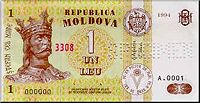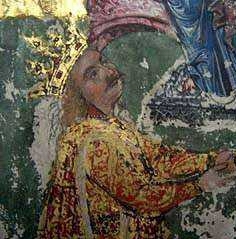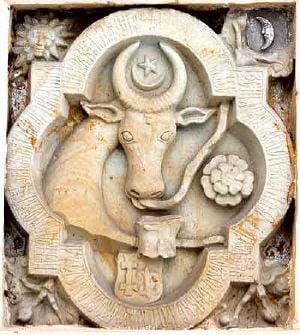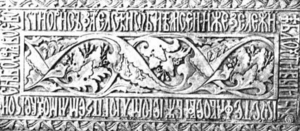Stephen III of Moldavia
| Saint Stephen the Great "Saint Voivode Stephen the Great" | |
|---|---|
Miniature from the 1473 Gospel at Humor Monastery | |
| Prince of Moldavia | |
| Born | ca. 1433 in Borzeşti(?), Romania |
| Died | July 2 1504 in Suceava, Romania |
| Venerated in | Romanian Orthodox Church |
| Beatified | June 12 1992, Bucharest, Romania
by Romanian Orthodox Church |
| Canonized | July 12 2006, Putna Monastery
by Romanian Orthodox Church |
| Major shrine | Putna Monastery |
| Feast | July 2 |
| Patronage | Romania |
Stephen III of Moldavia or Stephen III (c. 1433 - July 2, 1504), also known as Stephen the Great (Romanian: Ştefan cel Mare; Ştefan cel Mare şi Sfânt, "Stephen the Great and Holy" in more modern versions) was Prince of Moldavia between 1457 and 1504 and the most prominent representative of the House of Muşat.
During his reign, he turned Moldavia into a strong state and maintained its independence against the ambitions of Hungary, Poland, and the Ottoman Empire, which all sought to subdue the land. Stephen achieved fame in Europe for his long resistance against the Ottomans. He was victorious in 34 of his 36 battles, and was one of the first to gain a decisive victory over the Ottomans at the Battle of Vaslui, after which Pope Sixtus IV deemed him verus christianae fidei athleta (true Champion of Christian Faith). He was a man of religion and displayed his piety when he paid the debt of Mount Athos to the Porte, ensuring the continuity of Athos as an autonomous monastical community.

Early life and rise to power

Stephen was a member of the ruling Muşatin family. His father Bogdan II had ruled Moldavia for two years (1449 to 1451) before being killed in a stealthy raid lead by Stephen's uncle, Petru Aron. Bogdan II was attending a wedding of one of his boyars - who apparently was in collusion with Petru Aron - and the surprise was complete. Stephen barely escaped with his life, but his father was captured and beheaded on the spot by his half-brother Petru Aron. Between 1451 and 1457, Moldavia was turmoiled by civil war between Petru Aron and Alexăndrel - a nephew of Alexandru cel Bun.
Following the outbreak of the conflict, Stephen took refuge to Transylvania, seeking the protection of military commander John Hunyadi. After that, he moved to the court of Vlad III Dracula and, in 1457, managed to receive 6,000 horsemen as military assistance, putting them to use in a victorious battle against Petru Aron at Doljeşti, nearby Roman. Following another lost battle at Orbic, Aron fled to Poland, while Stephen was crowned Prince. Two years later, he led an incursion into Poland in the search for Aron, but was met with resistance. Instead, a treaty was signed between Moldavia and Poland, through which Stephen recognized King Kazimierz IV Jagiellon as his suzerain, while Aron was barred from entering Moldavia.
Rule
at Războieni (Battle of Valea Albă) the next year, but the Ottomans had to retreat after they failed to take any significant castle (see siege of Cetatea Neamţului) as a plague started to spread in the Ottoman army. Stephen's search for European assistance against the Turks met with little success, even though he had "cut off the pagan's right hand" - as he put it in a letter.
Menaced by powerful neighbours, he successfully repelled an invasion by the Hungarian King Matthias Corvinus, defeating him in the Battle of Baia (in 1467), crushed an invading Tartar force at Lipnic and invaded Wallachia in 1471 (the latter had by then succumbed to Ottoman power and had become its vassal). When the Ottoman Sultan Mehmed II launched a retaliation attack on Moldavia, Stephen defeated the invaders at the Battle of Vaslui in 1475, a victory which temporarily halted the Turkish advance.
Stephen helped to oust Vlad Ţepeş's brother, the pro-Ottoman Radu the Handsome, whose daughter he would marry, and installed Laiotă Basarab the Old on the throne in the hope of bringing Wallachia back into the Christian camp. This proved to be illusory, as Laiotă quickly turned his back on Stephen, deeming that Ottoman protection would better help him consolidate his rule. With Stephen's support, Laiotă was removed from the throne in 1482 by Vlad Călugărul, brother to Vlad Tepes, and for the remainder of the 15th century Wallachia remained relatively stable under his rule.
After 1484, when he lost the fortresses of Chilia Nouǎ and Cetatea Albǎ to an Ottoman blitz invasion, Stephen had to face not only new Turkish onslaughts which he defeated again on November 16, 1485 at Catlabuga Lake and at Şcheia on the Siret River in March 1486, but also the Polish designs on Moldavian independence. Finally on 20 August 1503[1] he concluded a treaty with Sultan Beyazid II that preserved Moldavia's self rule, at the cost of an annual tribute to the Turks.
From the 16th century on, the Principality of Moldavia would spend three hundred years as an Ottoman vassal. In his late years, he dealt successfully with a Polish invasion, defeating the Poles at the Battle of the Cosmin Forest. Stephen died in Suceava, and is buried in the Monastery of Putna.
Legacy
Though it was marked by continual strife, Stephen's long reign brought considerable cultural development; many churches and monasteries were erected by Stephen himself; some of which, including Voroneţ, are now part of UNESCO's World Heritage sites.
Stephen was seen as holy by many Christians, soon after his death. He has been canonized a saint by the Romanian Orthodox Church under the name "The Right-believing Voivod Stephen the Great and the Holy".
In a 2006 Romanian national television campaign on TVR 1 (see Mari Români), Stephen III was voted by almost 40,000 viewers as the "Greatest Romanian" of all times.
Popular Culture
- Stephen appears in the game Stronghold Legends, where he is called "Stefan Cel Mare". He is portrayed as a young and heroic character, who in many ways could be seen as the main protagonist. Early in the game, he fights his uncle, Petru Aron, and has a close relationship with his cousin, Vlad the Impaler. Later, he marries Maria Voichita, and wages war against her father, Radu. He wields a pair of Chakrams.
| Preceded by: Petru Aron |
Prince/Voivode of Moldavia 1457-1504 |
Succeeded by: Bogdan III cel Orb |
| ||||||||||||||
See also
- Borzeşti
- Borzeşti Church
Notes
- ↑ Uliantski, Mamerualyi, p. 195
ReferencesISBN links support NWE through referral fees
External links
- Muşatin family Retrieved November 10, 2008.
- Article in Romanian: Vlad Ţepeş şi Ştefan cel Mare - Prieteni sau duşmani? Retrieved November 10, 2008.
- Map of Moldavia under Ştefan cel Mare, 1501 Retrieved November 10, 2008.
- The Princely Court of Ştefan's son, Alexandru, in Bacău - images, layouts (at the Romanian Group for an Alternative History Website) Retrieved November 10, 2008.
- Map of Romania during Ştefan cel Mare Retrieved November 10, 2008.
Polish chronicles
- Library of Wielkopolska the online access to the oldest Polish writing relicts Retrieved November 10, 2008.
Credits
New World Encyclopedia writers and editors rewrote and completed the Wikipedia article in accordance with New World Encyclopedia standards. This article abides by terms of the Creative Commons CC-by-sa 3.0 License (CC-by-sa), which may be used and disseminated with proper attribution. Credit is due under the terms of this license that can reference both the New World Encyclopedia contributors and the selfless volunteer contributors of the Wikimedia Foundation. To cite this article click here for a list of acceptable citing formats.The history of earlier contributions by wikipedians is accessible to researchers here:
The history of this article since it was imported to New World Encyclopedia:
Note: Some restrictions may apply to use of individual images which are separately licensed.



